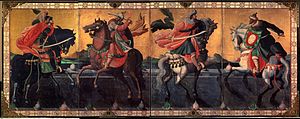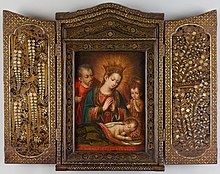
Back Namban-Kunst German Nanban Spanish Art Nanban French אמנות נאנבאן HE 南蛮美術 Japanese നാൻബാൻ ആർട്ട് Malayalam Arte Nanban Portuguese Намбан Russian ศิลปะนัมบัง Thai



Nanban art (南蛮美術) refers to Japanese art of the sixteenth and seventeenth centuries influenced by contact with the Nanban (南蛮) or 'Southern barbarians', traders and missionaries from Europe and specifically from Portugal. It is a Sino-Japanese word, Chinese Nánmán, originally referring to the peoples of South Asia and Southeast Asia. During the Nanban trade period, the word took on a new meaning when it came to designate the Portuguese, who first arrived in 1543, and later other Europeans. The term also refers to paintings which Europeans brought to Japan.[3][4]
- ^ 南蛮屏風 Kobe City Museum
- ^ 泰西王侯騎馬図 Kobe City Museum
- ^ Okamoto, Yoshitomo (1972). The Namban Art of Japan. Weatherhill. ISBN 0-8348-1008-5.
- ^ "Nanban-e". Japanese Architecture and Art Net Users System. Retrieved 28 March 2011.